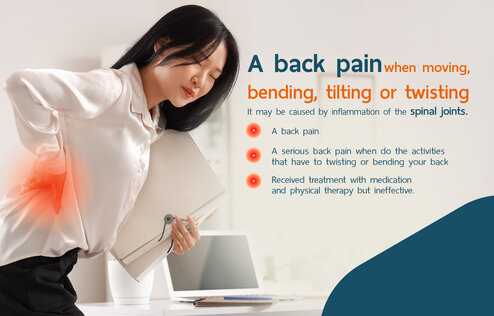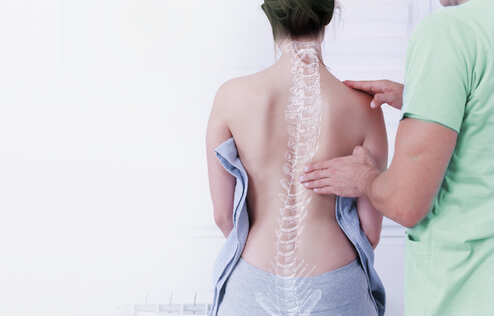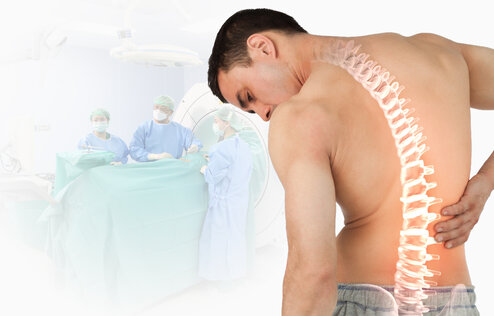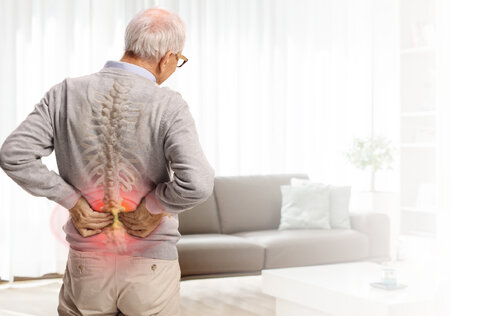Non Surgical Back Pain Treatment in Bangkok
Center : Spine Center
Article by : Dr. Bordin Varodomvanichkul
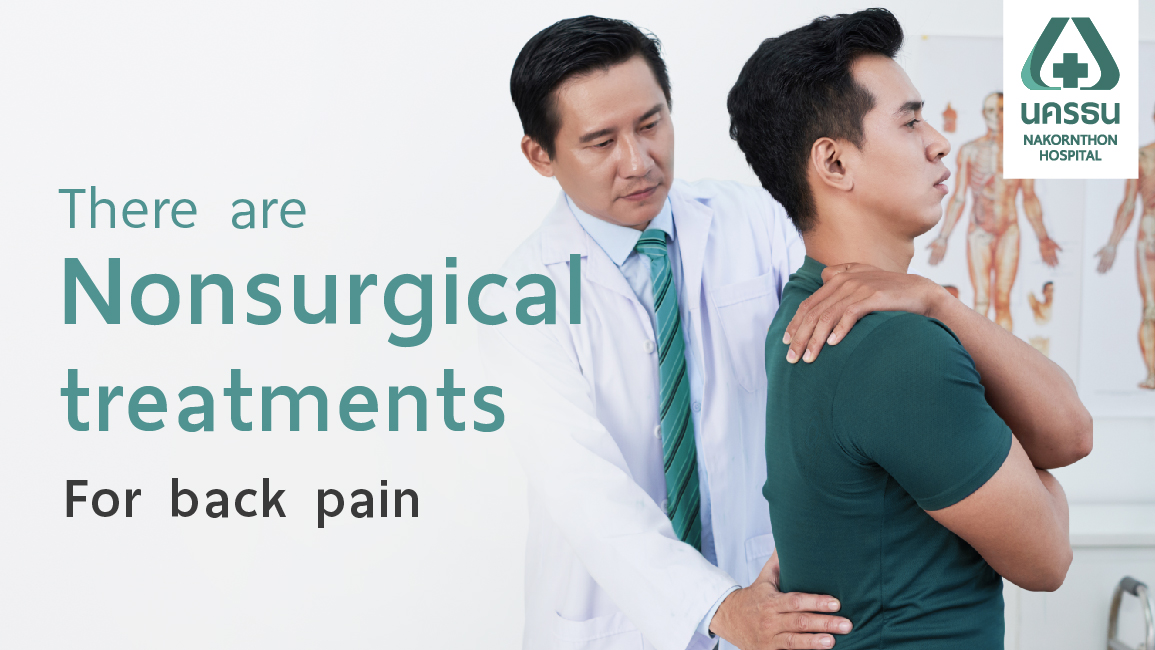
Back pain is one of the most prevalent disorders in working adults, especially in the older adults. Generally, back pain usually presents itself with chronic, dull ache with or without intermittent interval. The symptoms disturb physical health and daily activities. Some examples of back pain causes are traumatic injury, a prolonged incorrect posture, and degenerative spine conditions, such as spondylosis and herniated disc. Back pain is treatable with both surgical and non-surgical methods. In this article, we will provide you with information about non-surgical back pain treatment.
Table of Contents
What is Back Pain
Back pain is generally defined by the painful sensation spreading through the back, usually at the lower back. Back pain can develop in every age despite the frequent prevalence in working adults. People with back pain usually feel chronic pain and dull ache at the site of the condition. However, in some cases, the sudden, acute pain may occur due to muscle or ligament injuries as well. This condition usually occurs because of improper movement, overexertion, or injuries.
Back Pain Symptoms
People with back pain may experience different feelings, yet there are some common symptoms, which are:
- Pain that is dull or achy, mostly contained to the low back
- Muscle spasms in the lower back, pelvis, and sometimes, hips
- Radiating pain into the hips or legs, including burning pain, numbness and tingling sensations.
- Pain that worsens after prolonged sitting or standing
- Difficulty standing up straight, walking, or going from standing to sitting
Chronic Back Pain Symptoms
Back pain can be either acute or chronic. Even though back pain is a common term used to describe the pain in the back, most people associate this condition with chronic back pain. To be able to identify which type of back pain you are now experiencing is helpful. Here are the lists of chronic back pain symptoms you may want to check out.
- Dull, aching pain. People with chronic back pain usually experience dull, aching pain due to the muscles and joints problems. Burning sensations, stinging, or sharp pain are rather uncommon. The pain may be accompanied by muscle spasms as well. Movements, such as bending or twisting, can be limited due to pain. The dull ache can also radiate into the hips and legs, depending on the severity of the condition.
- Radiating pain. (Pain that travels down to the buttocks, the hips, the legs, and sometimes, the feet.) This condition is usually involved with nerve irritation, mostly sciatic nerve, which results in “Sciatica”. However, the sensations usually appear on just one side of the body. The pain travels down with the map of sciatic nerve innervation, causing an apparent pattern.
- Pain becomes worse after prolonged sitting. Usually, the pain will become worse due to the pressure applied to the spinal vertebrae and the discs. Back muscles usually get stiff after prolonged sitting, and in some cases, prolonged standing and walking. This symptom often indicates back problems.
- Pain that is worse after waking up and better after moving around. When you experience back pain first thing in the morning, this is usually caused by various factors: decreased blood flow with sleep, long periods of rest (which result in back muscle stiffness), and possibly the quality of mattress and pillow used.
See a Doctor Immediately If
Despite the fact that back pain can resolve itself with time, some people may experience chronic back pain, which is difficult to improve by only taking a rest. In some cases, proper treatments are recommended. The symptoms that indicate the need to seek professional advice are:
- The pain has been continuing for more than 3 months.
- Back pain with radiating pain into the hips, the legs, the calves, or the feet.
- Acute pain which is unimprovable with rest. The pain has become so severe that it disturbs normal functions, such as moving around.
- Night pain. The severe pain that wakes you up in the middle of the night.
- Back pain due to an injury or the fall.
- Back pain that is accompanied with other symptoms: uncontrollable bowel movements, incontinence, weakness and numbness in the legs and the feet, nausea, vomiting, fever, and unexplained weight loss.
If you are experiencing the aforementioned symptoms, it is recommended to seek professional help. Non-surgical back pain treatments are usually considered the first step of treating back pain. Back pain, in the early stage, is mostly treatable. If you are now having a back pain issue and living in Bangkok, Nakornthon Absolute Spine Center offers you a one-stop service: diagnosis, treatment, and prevention. The hospital offers you a good care of your health, conducted by experts and specialists, together with the innovative medical technology. Nakornthon Hospital is one of the best choices for you to consider regarding non-surgical back pain treatments.
6 Non Surgical Back Pain Treatments in Bangkok
Nakornthon Absolute Spine Center offers you a thorough service for non-surgical back pain treatment. The service basically consists of physical examination, diagnosis, treatment, and prevention. Starting with the thorough examination to precisely diagnose the diseases, Nakornthon Hospital offers you a variety of non-surgical treatments to choose, depending on your conditions and your doctor’s medical consultation. Here are some examples of non-surgical back pain treatments provided by the hospital.
Palliative treatment is mostly considered the first step in treating back pain. The doctor will prescribe you painkillers, such as paracetamol. The prescription is varied depending on your condition and the severity of the symptoms. Physical therapy may also be considered in case of severe or chronic back pain. In people with herniated disc, the doctor may initially suggest a bed rest in the acute phase. A bed rest on the firm mattress made of coconut fiber or hard-pressed rag is recommended.
2. Injection into the spinal cavity
Steroid injection into the spinal cavity. Steroid injection used in this procedure is a combination of corticosteroid and anesthetic. The nerve-relating symptoms, muscle weakness and numbness, are mostly caused by the excess pressure applied to the nerve, resulting in the condition called “nerve root compression”. The injection will help reduce nerve inflammation and swelling. It also helps improve blood circulation to the spinal nerves, and alleviate the symptoms.
Spinal Injection is mostly indicated for people with herniated disc disease, spinal stenosis, or degenerative spine disorders with radiating pain into the hips or the legs. Since the injection is low-risk and effective in relieving pain, the procedure is considered to be one of the most popular non-surgical back pain treatments. Statistically, the steroid injection can reduce pain by 60-70% for a period of at least 6 months.
Suitable candidates for the spinal cavity injection are:
- Those who have severe pain and are unable to perform daily activities.
- Those who have night pain.
- Those whose symptoms do not get improved by other non-surgical treatments, such as oral medications and regenerative medicine.
- Those who are suggested by their doctors to have steroid injection.
3. Reducing back pain by using radio frequency
Radio Frequency or Radiofrequency Ablation (RFA). RFA (a radiofrequency nerve stimulation) is a method used to relieve pain and reduce joint inflammation. The procedure involves using radiofrequency heat to reposition the spinal joints, pelvic joints, or relating nerves. It can be performed both at the neck and at the back. RFA is another choice for patients who want to consider non-surgical back pain treatments.
Neural transmission is related to transferring a sensation of pain via the spinal cord to the brain. The RFA process is performed to block neural signals, resulting in pain blockage. The procedure usually lasts about an hour. The main advantage of RFA is that the patients do not have to stay overnight at the hospital. They can go back home and continue their routines. However, it is recommended that the patients undergoing RFA do not drive a car after the procedure. Having a travel companion should be helpful.
4. Facet Joint Injection or Facet Nerve Injection
Facet joint injection or Facet Nerve injection. The procedure is aimed to reduce facet joint inflammation, consequently resulting in pain relief. The method helps in back pain diagnosis as well. It is one of the most practical non-surgical back pain treatments due to its effectiveness. The injection is low-risk, quick, and can be performed with outpatients.
The injection mainly consists of anesthetic and steroid medication. Its targets are the facet joints or related spinal nerves that present the symptoms. The procedure is recommended for people undergoing other non-surgical back pain treatments, but have no improvements regarding the conditions. The doctors may specifically suggest this procedure to people with facet joint inflammation as well.
5. Physical Therapy
Physical therapy can help improve back pain. The treatments are varied, depending on your conditions and health issues. Generally, manual technique, therapeutic ultrasound therapy, and electrical stimulation are used to relieve pain. It also involves stretching exercise, and core stabilization exercise. Physical therapy is mostly done together with oral medications.
6. Lifestyle Change
Changing your lifestyle is considered to be one of the best back pain preventions in the long term. You may consult your therapists about what you should, or should not do. Normally, lifestyle changing consists of
- Maintaining a correct posture.
- Avoid prolonged periods of sitting or standing.
- Avoid lifting heavy objects.
- Ergonomics adjustments.Ergonomics adjustments.
- Maintaining a healthy weight and exercising regularly.

Non Surgical Back Pain Treatment Conclusion
Despite its prevalence, back pain is treatable. The general symptoms of back pain are dull ache in the back, muscle spasms, and pain that gets worse with prolonged sitting or standing. Generally, non-surgical back pain treatments will be considered the first step to treat the conditions. It is recommended that you seek professional advice before making a decision regarding treatments.
For more information, please contact:
- - Website : https://en.nakornthon.com
- - Facebook : Nakornthon Hospital - International Patient
- - Line : @nakornthoninter
- - Tel: 02-450-9999 (Available 24 hours)
Free Online Consultation
Article of Spine Center



